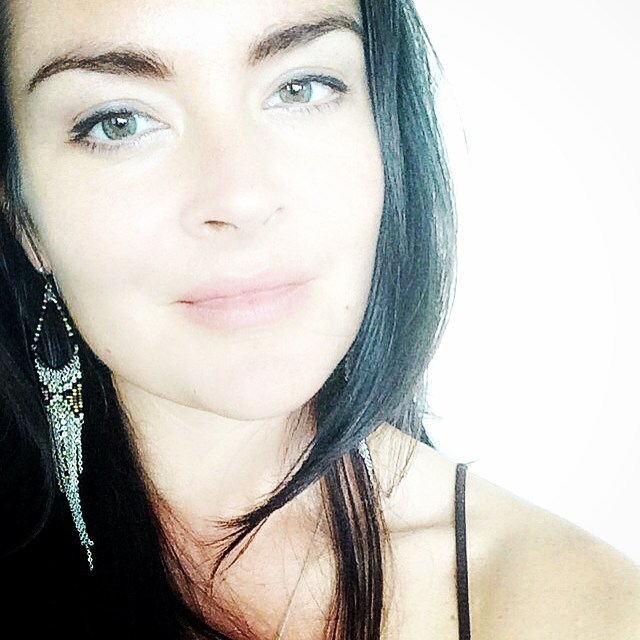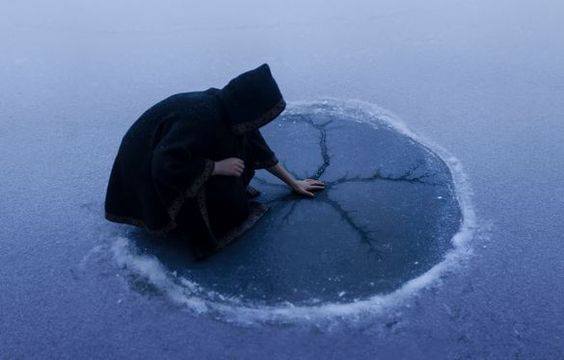Anilah
2017-02-01
by Niklas Göransson
Canadian vocalist and composer Dréa Drury performs ambient art which incorporates shamanism, quantum theory, psychoacoustics, ethereal tranquillity, and the archaic music traditions of Vedic mysticism.
– My primary intention with ANILAH is to create space for the listener, says Dréa, allowing them a step back from everyday consciousness. I feel as if people in general need a different reference point, so if this can be achieved by music – that’s fantastic.
Dréa is a vocalist and composer currently based in the Selkirk Mountains of Western Canada, she started the solo project ANILAH in 2011.
– When I first began composing music it was quite heavy, dark and metal oriented. One of my first bands was a sort of prog metal, post-rock project. After leaving them I went on a five-year journey where I studied a wide range of subjects; studio engineering, music therapy, shamanic practices, psychoacoustics, classical Indian raga and so forth. It took a few years to bring all of my roots together under one foundation, with the result being my 2014 EP; ”Warrior”.
My introduction to ANILAH was the alternate title track version on which Dréa collaborated with Einar Selvik of WARDRUNA, released in 2015. As I went on to investigate the original song, I was quite surprised with the appearance of distorted guitars and double bass drums towards the end.
– That’s a direct result of my background in and love for metal, which I believe is one of the most cathartic experiences available to the listener. After delving really deep into animistic components – exploring how different frequencies affect the nervous system and elicit an almost emotional response, it made the most sense to combine all of those elements.
Besides ”Warrior”, the EP contains three additional songs that the promo sheet refers to as ’invocations’.
– The title track is more of a traditional song that’s been arranged and edited. With invocations, I’m referring to recordings made completely by feel in a live ritual setting. There’s no premeditated composition – the music was created in the moment I recorded it, and there’s been no tinkering with it afterwards.

Despite the absence of musical preparation, Dréa puts in significant groundwork leading up to the recording.
– The vocals are performed from a deep flow state, but there’s a lot of preliminary efforts behind them; ritual pranayama for instance, or entering altered states of consciousness through personal practice or sacraments. Fire ritual is another exercise that I’m a huge fan of.
Are we talking outright arson here, or something akin to the yogic breath of fire?
– I have used physical fire in the past, with actual offerings to the flames for building up potency of whatever energy one seeks to work with. It’s such a powerful way of collecting energy, but I’m not sure how to translate that into words. But yes, I also work extensively with pranayamic breathing.
Hyperventilation techniques are a most potent avenue of consciousness alteration. Cheap as well.
– Many of the ones I’ve learned come from the kundalini tantric tradition. Mysticism aside, they’re really just ways of hacking into your nervous system – which is very beneficial for an artist who wants to work with the different elements.
The most prolific proponent of oxygenation-induced mind-warpage is probably Dutchman Wim Hof, who has 20 Guinness World Records to his name. He runs marathons above the Arctic Circle wearing nothing but his smallclothes, as well as in the Namib Desert without a drop of water. A university hospital injected him with a bacterial endotoxin that should have stricken him ill, but he was able to repel it by manually activating his autonomic nervous system – hitherto believed impossible. Hof then brought in ten people he had trained himself, who all replicated the feat. This is done with nothing but a breathing technique he discovered himself, while exploring body and mind.
– Oh, yeah – he’s amazing. It’s incredible what he’s doing with the ice baths, swimming in cold water, climbing Mount Everest in underwear and so on. I tried this breathing technique last year when I was at a hot spring, and went into the ice pool. I was able to experiment with the breathing, and honestly it was very profound – it really does work.
To understand the essence of ANILAH, we will scrutinise the different disciplines that have been stirred together in the cauldron brew. We start with the somewhat less esoteric end of the spectrum; sound engineering.
– I realised early that learning to record myself was the only way I was going to have the freedom I wanted as a musician. My home studio setup is a fairly simple affair, but it allows me to go into recording sessions as a ritual. This means I can capture the entire performance, as well as the message and energy behind it.
Learning to channel intent and power into recording, she continues, is a must in order to unlock the gifts of auditory restoration.
– There are two facets to this – one being the healing potential of sound, as pertaining to the ability of influencing human emotion. Music is an alchemical process – and if the composer is aware of the different nuances in scales and intervals woven into their work, it’s possible to affect the listener.
The second aspect is the power of frequency-specific healing, and how it correlates to matter.
– Cymatics; the study of how resonance and sound moves the physical – producing form through frequency alone. Just consider that … the implications are huge, it’s a vast field largely untouched until now so I’m really excited to hear about its evolution.
Frequential work also ties in to the field of psychoacoustics; the understanding of music and sound as stimulus to the human nervous system.
– Our heartbeat adapts to external rhythms. For example, percussion has the ability to either slow down or speed up our pulse – that in itself is fascinating and has a lot of implications. Something clearly happens between the mind and incoming sound, and musicians who can play in those realms open up entirely new dimensions of composing.
In the Cory Allen interview, we discussed one such technology of regulating physiology with the audible; binaural beats.
– That’s fascinating, because as you know – the brain will actually spark a third tone that entrains the mind into a different state. This entire area of research is still young and we don’t know enough about it. It’s something I follow closely, it’s very useful knowledge for composition.
The raga is one of the building blocks of classical Indian music traditions, and there’s nothing comparable in Western music theory. The concept builds on at least five different notes – around which the musician is free to play in whatever order he or she wants, as long as they are either descending or ascending.
– I initially became attracted to it when I was about 19 and studying in music college. I’ll never forget the first time I heard a female vocalist perform traditional ragas, it was total magic – I was completely transfixed and from that point became somewhat obsessed with studying that lineage. What drew me to it was the compositional approach; it’s entirely unlike the Western model, highly complex but at the same time there’s a lot of room for what I call divine intervention.
Dréa explains that ragas allow the use of complex scales and intervals, but at the same time leaves a lot of room for improvisation. This brings to mind her incantation recording approach.
– It’s almost like an in-the-moment dialogue or conversation with something other than myself. It’s just the way of instinctive composition, it leaves a lot more room for the unexpected to happen.
According to tradition, ragas are woven together with a set purpose and are considered potent in encouraging certain emotions – also said to have the power of ’colouring the mind’.
– That’s another fascinating aspect; the more you learn about it, you realise how on one level it’s an art form – music, but on the other hand it’s a science. The end result is essentially that each raga or scale is a prescription with purpose.
In contemporary India, the most common raga applications pertain to specific seasons, times of day, or emotions.
– My teacher came from a very long lineage and he told me his grandfather once played a raga that could affect the weather and fire. That’s on another level.
But … how does that work?
– The closest language we have to speak about this is quantum theory, it’s something we don’t fully understand at this point. The interplay of frequency, intervals, harmonic resonance and matter – how all these things work together, we have no idea. I’d say a combination of these things could explain how certain musical scales can affect physical matter.
Usually when my interviewees speak of activities with these intentions, they call them spells.
– I would say that on one level, definitely – but the word ’spell’ could have a lot of negative connotations for some people if they don’t understand what magic is.
I presume there is some manner of raga implementation in ANILAH.
– I use specific scales which I learned from my teacher. However, I would say that at this point I’m primarily interested in the intuitive elements. Writing music adhering to that set of rules presents a lot of limitation, which is what I came up against when I began working under them. You can start out with a certain aim, only to realise that the composition has its own agenda – and as an artist you have to get out of your own way.

Another rarely cited musical inspiration that Dréa mentions as highly influential is silence.
– For me, personally and as a musician, I would say that silence has been the greatest teacher I’ve ever had. It has allowed me to create a space in my consciousness where I can listen in a different way. I’ve had the opportunity to do it for prolonged periods.
Like Vipassana retreats?
– I’ve done several of those; they’re among the best experiences of my life – as well as some of the hardest. I also facilitate my own retreats when I can, alone in nature.
Vipassana is a ten-day silent retreat in a strictly ascetic milieu. For a more detailed account, see the conversation with Tyler Davis of The Ajna Offensive. It’s commonly reported that having gone a few days without speaking or hearing talk, without engaging the parts of the human mind reserved for external communication – there’s a palpable alteration to one’s perception.
– Something happens with the consciousness, it opens this entirely new language of listening. Basically, it changes and enhances the dialogue between your mind and nature. That’s another element of the greatest import to me in my musical work with ANILAH.
Dréa says that a significant part of her music derives from states of being fully engaged in inner conversation with her environment.
– Many artists and musicians become prisoners of their own mind – especially if they live in a city, locked into a very condensed state of being. That’s certainly one benefit of living in nature, I have direct access to organic tranquillity.
Do you listen to your own music?
– I do, but these days it tends to be reserved for specific moments. It’s highly beneficial if I feel like I need to switch emotional state. Listening to it gives me a real boost of power and focus; there’s this bizarre, natural feedback where I hear my own voice. It’s almost like my personal medicine in a way.
Given the nature of their recording, I’m curious if there are any esoteric properties to singing along.
– Yes, that’s really potent – I can only describe it as being hooked up to a battery. It basically super-charges me on several levels.

Music and song appear to be intrinsically linked to ceremony and religious festivities, I’m not aware of any culture that doesn’t have it.
– Sound has always been fundamental to ritualistic practices. In terms of ANILAH, ‘shamanic’ is a term I’ve used to describe aspects of my work in the past and I would say that in some regard, yes – it is, such as the intentional use of rhythm and tone. It’s essentially a way to manipulate currents in the quantum realm – to either direct, hone or dispel energy. Note that I’m using the word ’energy’ in loose terms here, because I honestly don’t know what else I can use to describe it.
As per usual, the conversational paths of shamanism inevitably lead to pastures of the blessed shrubberies.
– Sacred plants were pretty readily available where I was raised, so my introduction to them came at a young age. There were many social events where you could partake in these ceremonies.
Where the hell did you grow up?
– An alternative community in the Kootenay region of British Columbia, the nearest town would be Nelson. It’s a very eclectic gathering of artists, musicians, healers as well as the normal folk that have lived there for generations. The area tends to attract a lot of different people from all around the world, so there would often be shamans passing by offering plant ceremonies.
Dréa mentions that because of her familiarity with these realms, most of her current-day practices are devoid of exterior agents. She goes on to explain that the advantage of having been introduced to psychoactive botany through a ritualistic framework, where the plants were approached with reverence and awe, is that they never became toys for revelry.
– I try to always enter these ceremonies with a sense of humility – there’s just too much that can go wrong if you carry an agenda or ego. At some point, I realised I could learn by just remaining open – surrendering to what was coming through. I then started combining my creative process with the exploration of these states.
In what setting would this usually take place?
– That depends entirely on if I’m alone or in a group setting. In the latter case there will be a shaman present, which makes for an entirely different experience. A lot of problems can arise if plant medicines are taken without the proper respect and care, especially in unsuitable settings or company.
The entheogenic experience, she says, will be vastly different if the traditional framework is missing.
– When people come to me and ask about these matters, I always say that really, if you want the full experience, it has to be within proper context. You also need to do the necessary preparatory work … the internal and emotional cleansing, meditation and dieting.
Before consuming the South American plant sacrament ayahuasca for instance, one is required to undergo a strict diet for weeks ahead. This entails adhering to a bland diet of mainly boiled rice and vegetables – abstaining from salt, spices, meat, dairy, alcohol, wheat, and so on.
– I also feel that meditation is essential when working with teacher plants – at least fifty percent of the actual experience. If you don’t know how to control your mind going in, then you’re really just riding an ethereal roller coaster.

Have you suffered any ceremonial misfires?
– Heh, she chuckles, a few. One of the most challenging ordeals I’ve ever been through was the first time I worked with Salvia divinorum, if you’re familiar with that.
As it happens, this is another topic covered by the Ajna Offensive interview.
– My friend and I opted for the method where you hold the concentrate in your mouth for a really long time, so the plant enters through your gums… and then you smoke the leaves. Turns out that’s a particularly potent way to take the medicine, I wasn’t quite expecting what happened.
Oral ingestion will typically render a semi-coherent visionary trance state that lasts for several hours. Smoking the dried leaves catapults one into an approximately ten minute-long guided tour of a completely free-standing and distinctly alien dimension – often containing sentient beings who attempt to interact and communicate, which can be extraordinarily confusing. What this intake combination would orchestrate is easy to figure out.
– It left me with a sense of true terror, and that feeling was infinitely humbling. It occurred to me I had entered into something I was unprepared for, that I wasn’t ready for what was being shown to me – the plant made that infinitely clear as soon as I switched over into its realm. And physically it was very painful, I felt as if I was being dragged out of my body.
This is the sensation known as ’Salvia gravity’ or ’Salvia pull’, commonly reported during the launch phase. For the unprepared, the rapid intensity with which consciousness is ejected from the corporeal vessel can be quite alarming. Fortunately, Dréa has a decent control over her mind, stemming from tribulations in early life.
– There have been episodes when I was forced inwards, where I found resources I never knew existed. The first time was at fifteen years of age, I got a really bad viral infection and was bed-ridden for about six months.
In total, it took Dréa more than a year and a half to recover – which gave her plenty of time for introspective contemplation.
– It was a time of seeking refuge within because I was so sick. I feel like those periods have been highly resourceful for me in terms of becoming intimate with the many different layers of my consciousness. As an artist, that’s been very helpful too.
New ANILAH music, she reports, is underway.
– The material has similar aspects to “Warrior”, but there are a lot more choral aspects, multi-layered vocal parts and so forth. Basically, what I have now is two albums worth of material. One is going to be more ritual chanting and the other heavier, featuring elements of metal.
Will ANILAH ever be brought to concert stage?
– Eventually – mainly focusing on outdoor performances I imagine, or ritual-like settings in small venues. The approach for live material has yet to be fully executed, so I’m not sure what form it will take exactly, but it will definitely include versions of all of the material; invocations and otherwise.
For more information about ANILAH, see the official website.



